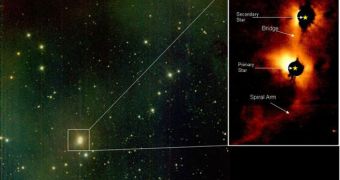One of the most peculiar things about our Sun is the fact that it is single. Most class-G stars, the type that includes our own, exist in binary systems, where two stars orbit each other. Astronomers have even identified triple star systems, and some experts infer that groups of as much as seven stars orbiting each other may exist in the Universe. These multiple-star systems make up about 67 percent of all class-G stars, experts say, and this is why they find it peculiar that the Sun is all by itself, and that we only experience one sunrise and sunset, Space reports.
When this field of research was in its infancy, many experts believed that binary, and more numerous, star systems were constructed in such a way that they couldn't have possibly allowed for the formation of planets. But subsequent studies have shown that not only is this possible, but that the phenomena are fairly natural. But the issue is that the vast majority of stars in the Milky Way, for example, are not class-G stars, but class-M stars. They are about half to one quarter the mass of the Sun, are very dim, and can be seldom found in binary or multiple systems. They also make up about 70 percent of the stars in the galaxy, astronomers write.
“If there are 400 billion stars in the Milky Way galaxy, then about 325 billion of those are M stars. They have a very low binary or multiple frequency – maybe only about 15 to 25 percent of such systems,” Charles Lada, an astronomer at the Harvard-Smithsonian Center for Astrophysics (CfA), in Cambridge, Massachusetts, explains. “Low-mass stars tend to form in very dense, cold, dark clouds,” Lada says. “They are born when gravity wins out, causing these 'cores' to contract further, usually forming single systems. On the other hand, massive cores tend to be turbulent, with gas within generally moving at higher velocities. Those are very susceptible to fragmentation, and so can form multiple stars or binaries,” he adds.
The real question now is how planets form and evolve in binary systems. This has remained an unanswered question for may years, until Japanese scientists finally managed to capture a direct, high-resolution image of such a system. Using the Subaru Telescope, they were able to identify primary and secondary stars (the brightest/largest and faintest/smallest ones, respectively), and determine that each of them was surrounded by a disk. Such a structure around the primary star is called the circumprimary disk, while, around the smallest object, it's called the circumsecondary disk. The team also discovered that bridges existed between the two disks, and computer models revealed that these structures might have formed as gas clouds between the two stars that collided.
Additionally, it was shown that a third disk could be surrounding the entire binary system, and some believe that this structure may be acting in very much the same way a protoplanetary disk around a single star does. With this in mind, the Japanese team says, it could be that planets indeed orbit the SR24 binary system. The structure lies some 520 light years away, in the constellation Ophiuchus. “In such widely spaced binaries, you could have planets around the two,” Lada concludes.

 14 DAY TRIAL //
14 DAY TRIAL //